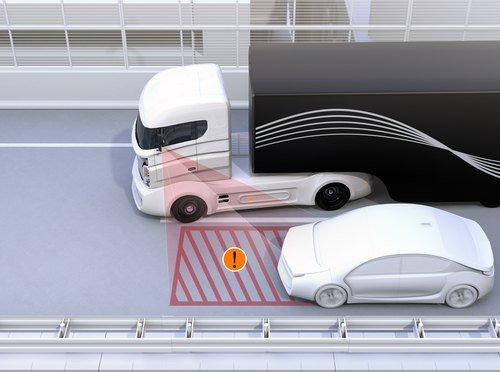
Blind Spot Truck Accidents in Chicago, IL
Chicago is one of the busiest places in the country. In fact, it is the third-most populous city in the United States, with a population of just over 2.7 million. In order to support industry in the city and meet consumer demand, large trucks are spotted traveling through Chicago on a daily basis, delivering various goods and materials.
While large trucks are essential, they can also be dangerous. Even when a truck driver is operating the vehicle responsibly, a truck accident is possible. One of the most common types of large truck accidents ─ and one of the most serious ─ is a blind spot truck accident.
If you or a loved one has been hurt in a blind spot truck accident in Illinois, our aggressive truck accident lawyers at Salvi, Schostok & Pritchard P.C. can help you to understand your legal rights.
Get help from the nearest truck accident attorney in Chicago
What Is a Blind Spot Accident?
A blind spot accident refers to a type of accident that occurs because the driver of one vehicle simply did not see the other vehicle (or pedestrian, cyclist, or motorcyclist), thereby running over, backing up into, running off the road, or side-swiping the other party. These crashes occur because the victim was within the driver’s “blind spot,” which refers to an area around a vehicle that cannot be directly observed by the driver during operation.
All vehicles have blind spots, but the blind spots on big trucks are especially large. For example, blind spot accident statistics noted by Consumer Reports reveal that while the average-height driver of a passenger car may have a rear blind spot of about 12 feet, a pickup truck driver will face a rear blind spot distance of about 24 feet.
Large trucks’ blind spots, referred to as “no zones” by the Federal Motor Carrier Safety Administration (FMCSA), are even bigger: 30 feet directly behind a large truck, two lanes to the right of a large truck, one lane to the left of the truck, and 20 feet directly in front of the large truck. This large area of impaired visibility poses a serious danger to those caught within it.
Common Causes of Blind Spot Collisions
A blind spot collision can happen for a variety of reasons, but the most common cause is simply that the driver of a large truck did not see the smaller vehicle within its blind spots, and therefore adjusted the truck in a way that impacted the smaller vehicle. This may result from:
- A passenger car tailgating or being tailgated by a large truck
- A truck driver’s aggression ─ i.e. tapping the truck’s brakes to get a driver to back off
- During a routine lane change, where the truck driver simply does not see the driver in his or her blind spot
- A passenger car “hanging out” in a large truck’s blind spots
Blind spot accidents are usually completely preventable. For truck drivers, it is important to know how to check blind spots while driving to ensure the safety of smaller cars around them.
Safety Tips When Driving Around Large Trucks
Although you cannot control other drivers on the road, there are some safety precautions you can take to protect yourself when driving near a large truck. Some of the best ways that you can avoid a blind spot truck accident as a driver of a passenger car include:
- Give large trucks plenty of room when you are changing lanes in front of them.
- Use your blinkers to let a truck driver know what you’re going to do.
- Never spend too much time in a truck driver’s blind spot ─ if you need to pass, do so quickly.
- Never pass a large truck on the right, where blind spots are larger and a truck driver is less likely to expect you.
- Never tailgate or engage in other aggressive behaviors around a large truck.
Injuries from a Blind Spot Accident
Failure to see another driver may result in a side-swipe accident, an over-ride or under-ride crash, or a passenger car being run off the road by the larger vehicle. In any case, the injuries that result could be very severe, and a driver or occupant of a passenger car may be left with serious medical problems in the form of:
- Traumatic brain injury
- Limb crush or amputation injury
- Back or neck injury
- Spinal cord injury
- Internal injuries
- Bone fractures
- Facial injuries
These injuries are costly, painful, and can leave a victim with long-term health issues. Our knowledgeable Illinois truck accident attorneys help crash victims demand full and fair compensation for both current and future damages.
Who Is at Fault in a Blind Spot Truck Accident?
Determining who is at fault for a blind spot accident can be complicated. It is impossible to determine fault in truck accidents caused by blind spots without a comprehensive investigation. In many cases, a truck driver’s failure to look is the cause. In some instances, though, there may be other at-fault parties.
Our blind spot attorneys will investigate your accident to get to the bottom of what happened and determine who should be held accountable.
What to Do Immediately After a Blind Spot Accident
Immediately after a blind spot accident, you need to:
- Seek medical care.
- Report the accident to the police and your insurer.
- Get the truck driver’s name, the name of his or her employer, insurance information, and contact information.
- Gather any evidence you can such as photos of the crash scene and your injuries.
- Write down the names and contact information for any witnesses.
Call our offices for immediate help after any truck accident. Our dedicated attorneys will launch an investigation into your crash right away and begin documenting the ways in which your injuries have affected you.
How Our Law Firm Can Help After a Blind Spot Truck Accident
Our respected Illinois personal injury lawyers are passionate about helping crash victims pursue the compensation that they need after a serious blind spot truck collision. For your free consultation, please contact our blind spot truck accident lawyers at Salvi, Schostok & Pritchard P.C. directly. We are here to help.







